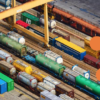Port access from the waterside requires local knowledge and skills. Pilotage services are key to ensure a secure, but also reliable movement of big ships on narrow water corridors towards and from the ports. This type of service is offered all over the world, in European ports like Antwerp, Hamburg, London, but also worldwide from Shanghai to Vancouver. The problem of efficient allocation of pilots to ships has evolved to a complex resource allocation problem and been given to computer programs. In the preparation of the SPEED Smart Port Ecosystem, we took a peak in the experience built at the Port of London Authority in building a centralized system. Insight information on the scope, barriers, and future vision on developing a Smart Port Ecosystem is given by Alistair Gale, Director of Corporate Affairs at Port of London Authority (PLA).
What is the perspective of a Smart Port Ecosystem?
The elements that contribute to building a Smart Port Ecosystem depend on each individual organization (stakeholder in the chain) to release its best intentions and tools in carrying out its activity. The Port of London Authority’s job is to ensure that the access infrastructure is kept clear and used at maximum capacity for the port operators and users. PLA ensures that the river channels are kept clear of obstruction and that they are deep enough for the ships calling the port. Beside this task, the PLA is also providing pilotage services and coordinates the movement of ships in the port. In this context, PLA has progressively an advanced practice that allocates a scarce resource, pilots, to ships moving towards and from the port, ensuring benefits to the community as a whole by providing a prompt reply to any pilot request.
PISCES: How does the service work that allocates pilots to ships?
PLA opened a secure web-based application (PISCES) so that ships’ Agents are able to provide vessel arrival and departure notifications and request for pilots. Through PISCES, the port control center receives the information about each ship when it is going to arrive and if, based on this specification, it holds a pilotage exemption certificate or PLA has to supply a pilot to and from its berth.
“Having the right information concerning the ETA of each ship is key. Missing information about a few ships leads to serious problems in making a decent planning.”
Alistair Gale, Director of Corporate Affairs at Port of London Authority
PISCES is used to precisely allocate the pilots to ships. PLA disposes of a number of pilots that are available and the computer checks the list of ships (with the related specification) and models when each of the ships would need a pilot. Based on this information, PISCES allocates a pilot to the ship. This algorithm is re-run constantly while the ships’ ETA change. Updates are calculated until the most efficient way of using the resource of pilots is reached, keeping in mind that no changes are possible four hours until the pilot is due to be on board of the ship. At that point, the pilot is assigned to the ship and no more changes are possible. The program checks in parallel several ships that are due to move from or towards the berths. The allocation of pilots to ships is very accurate and it relies on information provided by ships’ agents about many ships (players in the chain). If you don’t have the information concerning the ETA of each ship, it will be a serious problem to have a decent planning.
What was the process to get the ship agents and ships to share the information?
Over the last 10-12 years, PLA went through two substantial changes to technology which has progressively improved their pilotage operations. Firstly, the request of information in a centralized way at PLA was started in 2009 with a project called Optimizing Pilotage. The aim of that project was to make sure that the most efficient use of precious resources like pilots is achieved. The initial phase of the project showed that it was possible to have up to three different ETA’s for a ship. One ETA was calculated by the PLA, one was calculated by the ships’ agent and another one by the tug company. In that context, it was highly important to define “one version of the truth” and use only one reliable ETA. Secondly, the project created a dedicated computer program that was centralizing in a uniform matter the ETA’s of all ships and all the interested parties in that ETA would have access to check it. The program was called PISCES and it became the reference to ships’ ETA’s. The Optimizing Pilotage project enabled PLA to further develop in 2017-2018 the pilot allocation system that is currently in use.
What were the main barriers in developing a centralized system for ETA submission and pilot allocation?
The pilot allocation tool was a change on the internal processes of many stakeholders. The implementation of the pilot allocation system met two key barriers, one regarding people and the other regarding technology. As in any initiative to change processes, there was some people’s resistance, people prefer to be in control of things and planning themselves. It is only when people realize that a computer makes their job easier, they will adjust. In parallel, the new system asks a change from people inside the organization (PLA) but also from outside (ships’ Agents and vessels). There was a lot of communication and dialogue to implement this system, as in some cases there was no technology available on board of the ships to be able to provide the needed information online. It is enough to have a handful of ships that are not able to provide you the needed information to shake the reliability of the system as a whole. In the beginning, the information from these ships was still collected manually via phone and introduced into the system. Luckily, data with regard to ships’ ETA and the need or not of a pilot was information that was shared anyway, it was only a change on how this data is handled.
“If you change any process that involves people you will have always some opposition”
Alistair Gale, Director of Corporate Affairs at Port of London Authority
What were drivers to develop a centralized ETA and pilot allocation system?
The main drivers were to have an efficient use of scarce resources and benefits from a reliable ETA in decision making. In the last years, PLA experienced a very sharp demand for pilots, up to the point that it was very difficult to plan their scarce resources. Moreover, it takes 5 years to train a pilot to handle the bigger ships on the river sailing towards and from the port. The pilot allocation system had to be introduced. Equally, having reliable data on ships ETA’s was also key. There is always a trade-off between having reliable information and providing it as early as possible. The common sense tells that there are a lot of changes that can happen on the way from the departure to the arrival port for the ship voyages. A departure time from a port will hardly be regarded as reliable information to calculate an accurate ETA. There are many unpredictable elements like storms, technical problems, changes in slot bookings or captains’ will. These elements have a high impact on an early declared ETA and make it unreliable. The earlier the ETA is provided, the more chances are that this will be altered.
The benefits of this type of system is shared by everyone involved in the chain. Ultimately, the biggest benefit is that the shipping lines have great confidence that the pilots would be available when there is a need for them. Unreliable data and trying to meet demand with not enough pilots was damaging the image of the port.
What is still to be done to have a Smart Port Ecosystem?
Technology will definitely play a significant role in developing further the Smart Port Ecosystem. Once new technologies are introduced in practice, it is up to us, the people, to use them wisely to strengthen our Ecosystem relations. One type of technology is the development of autonomous vessels. People will need to already start thinking over what will be the impact on port operations and vessel handling when they can sail semi or fully autonomous. There is still a fundamental aspect regarding the value of these ships. Proper and robust computer programs need to be defined by us, the people. There is also another point that raises from the increased attention of the public on environmental concerns. Port authorities are the parties who enforce new environmental regulations. There will probably be changes that require that, beside information like GPS-tags etc., real-time data on ship emissions is also streamed and used in berth and port infrastructure allocation problems.
Interview carried and processed by Valentin Carlan, Post-doc Researcher at University of Antwerp, Faculty of Applied Economics/ Department of Transport and Regional Economics



